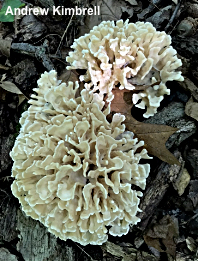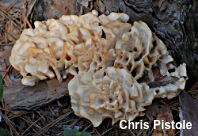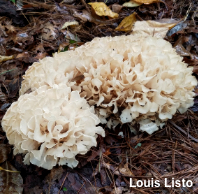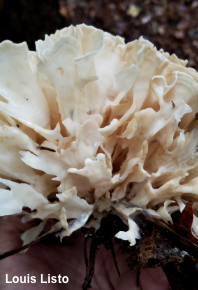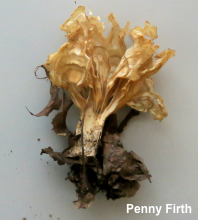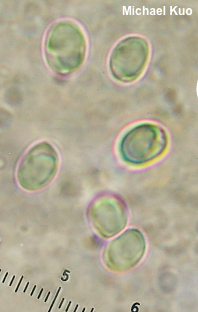| Major Groups > Clubs & Corals / Polypores > Sparassis > Sparassis spathulata |

|
Sparassis spathulata [ Basidiomycota > Polyporales > Sparassidaceae > Sparassis . . . ] by Michael Kuo This eastern North American species of Sparassis can be recognized by its flattened, more or less straight branches, which do not feature the tightly packed, curled and "noodly" appearance of the branches of Sparassis americana. Rather, the branches of Sparassis spathulata form a loose rosette—and the surfaces are usually zoned with more or less concentric shades of color. Unlike other North American Sparassis species, which are always associated with conifers, Sparassis spathulata can be found under pines or oaks. Sparassis spathulata f. herbstii (previously Sparassis herbstii) is a "form," or morphological variant, in which the tips of the branches are thickened. European records of Sparassis spathulata probably represent the similar Sparassis brevipes, which is, according to Petersen et al. (2015), endemic to Europe, while Sparassis spathulata is found only in North America. Thanks to Penny Firth, Andrew Kimbrell, Louis Listo, and Chris Pistole for documenting, collecting, and preserving Sparassis spathulata for study; their collections are deposited in The Herbarium of Michael Kuo. Description: Ecology: Pathogenic and saprobic; growing from the roots or bases of trees; found under hardwoods (especially oaks) or pines (species of Pinus, with bundled needles); annual, but often recurring yearly in the same location; causing a brown rot or a butt rot; summer and fall; originally described from North Carolina; fairly widely distributed in North America east of the Great Plains and below the Great Lakes. The illustrated and described collections are from Arkansas, New Jersey, Pennsylvania, and Virginia. Fruiting Body: 10–20 cm across; up to 15 cm high; forming a rosette of flattened branches which arise from a common, fleshy basal structure; branches thin-fleshed, with tips up to 1 mm thick, creamy whitish to yellowish or brownish (or, in age, slightly pinkish), usually featuring concentric zones of color, bald; flesh whitish, unchanging when sliced. Odor and Taste: Not distinctive. Microscopic Features: Spores 5–7 x 3–5 µm; ellipsoid; apiculate; smooth; hyaline in KOH; inamyloid. Basidia to 45 x 5 µm; subclavate; 4-sterigmate. Cystidia not found. Contextual hyphae 3–10 µm wide; smooth; walls to 0.5 µm thick; hyaline in KOH; clamp connections not found. REFERENCES: (Schweinitz, 1822) Fries, 1828. (Saccardo, 1888; Coker, 1921; Smith, 1949; Weber & Smith, 1985; Burdsall & Miller, 1988a; Phillips, 1991/2005; Metzler & Metzler, 1992; Barron, 1999; Roody, 2003; Wang et al., 2004; Blanco-Dios et al., 2006; Dai et al., 2006; Binion et al, 2008; Light & Woehrel, 2009; Ryoo et al., 2013; Zhao et al., 2013; Kuo & Methven, 2014; Petersen et al., 2015; Woehrel & Light, 2017; baroni, 2017; Elliott & Stephenson, 2018; Sturgeon, 2018; McKnight et al., 2021.) Herb. Kuo 10131803, 07201901, 08212001, 09042001. This site contains no information about the edibility or toxicity of mushrooms. |
© MushroomExpert.Com |
|
Cite this page as: Kuo, M. (2021, June). Sparassis spathulata. Retrieved from the MushroomExpert.Com Web site: http://www.mushroomexpert.com/sparassis_spathulata.html |
